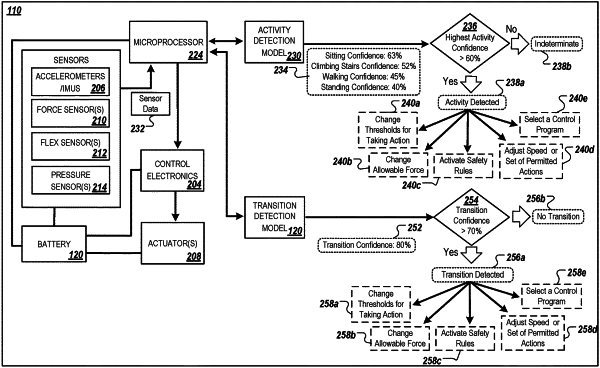| CPC G05B 19/4155 (2013.01) [B25J 9/0006 (2013.01); G06N 20/00 (2019.01); H04Q 9/00 (2013.01); G05B 2219/40305 (2013.01)] | 20 Claims |

|
1. A method performed by one or more computing devices, the method comprising:
classifying, by the one or more computing devices, a first activity of a wearer of a powered exosuit as a first type of activity, wherein the activity of the wearer is classified based on output generated by an activity detection model, the output generated by the activity detection model including a first set of activity confidence scores that include a confidence score for each of a plurality of types of activities;
based on the classification of the first activity of the wearer as the first type of activity, selecting, by the one or more computing devices, a first control program for the first type of activity from a plurality of control programs that are respectively designated for controlling the powered exosuit during different types of activities;
controlling, by the one or more computing devices, the powered exosuit using the first control program for the first type of activity and a set of control parameters; and
while controlling the powered exosuit using the first control program for the first type of activity:
receiving, by the one or more computing devices, sensor data for the powered exosuit;
obtaining, by the one or more computing devices, a second set of activity confidence scores generated by the activity detection model based on the received sensor data, wherein the second set of activity confidence scores do not satisfy a threshold needed to indicate a subsequent type of activity of the wearer;
without determining the subsequent type of activity of the wearer, detecting, by the one or more computing devices, that a transition of the wearer out of the first type of activity is likely, wherein the transition is detected to be likely based on output generated by a transition detection model based on the sensor data, the output generated by the transition detection model including a transition confidence score that indicates a likelihood that a change in activity is occurring without specifying the subsequent type of activity of the wearer;
in response to detecting the transition of the wearer out of the first type of activity based on the output transition confidence score of the transition detection model:
altering, by the one or more computing devices, the set of control parameters used with the first control program to control the powered exosuit; and
before the one or more computers determine the subsequent type of activity, controlling, by the one or more computing devices, the powered exosuit for a period of time using the first control program and the altered set of control parameters determined based on the output of the transition detection model.
|